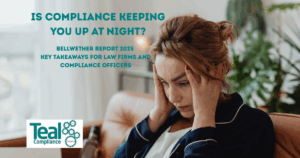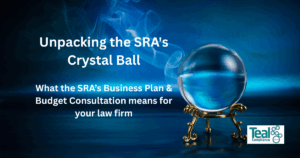Source of funds and source of wealth can be tricky because the regime we have is risk based. It’s not just about making sure you get bank statements. It’s also about the enquiries you make, the evidence you see, and what regulators think when looking at the work you’ve done.
Regulators want to know whether firms are doing this properly or not. Initially, the regulators were interested in firm-based risk assessments, did firms have one, did they assess the money laundering risks the firm was exposed to. They were then interested in whether law firms have their policies, controls and procedures in place.
Now, they’re looking at whether law firms are completing matter risk assessments. This is to ensure they have the right foundations for assessing the money laundering risks the firm is exposed to in respect of each matter. They’re also looking at identification and verification, including what checks you are doing, and what negative news are you looking at.
Eventually the focus will shift to source of funds and and source of wealth. This is because, you can’t stop money laundering by getting passports and utility bills. You can only stop money laundering by not moving dirty money. The enquiries you make in relation to source of funds and source of wealth are pivotal to the success of an AML programme. Therefore, I anticipate that regulators will start putting quite a lot of focus on that, on the basis that everything else is in place.
You can have perfect policies and procedures, with all boxes ticked. However, if a regulator can’t pick up a file and understand the source of funds and source of wealth work that’s been done, this is an issue. There therefore needs to be a proper process in place.
What’s the difference between source of funds and source of wealth?
Source of funds relates to where the funds of a transaction are coming from. You therefore need to consider what activity generated the funds, for example, salary, trading revenues or payments out of a trust. It relates directly to the economic origin of funds to be used in a transaction. Given funds are likely to be received via a bank account, source of funds would generally be evidenced by bank statements.
Source of wealth relates to how and why an individual has their wealth. You need to consider what activity generated their wealth, for example business ownership, inheritance or investments. Source of wealth can be investigated by taking reasonable steps to be satisfied that the funds used in a transaction appear to have come from a legitimate source.
The SRA on source of funds
A couple of years ago, the SRA released their findings and expectations when it comes to source of funds.
SRA Findings
The SRA’s findings included:
1. ”21% did not evidence the client’s source of funds properly or at all“
What this tells you is that they’re not just checking to see whether you have some paperwork on file. They’re assessing whether it’s enough.
2. ”Companies used filed accounts, but these are old and have no relation on the current amount”
Filed accounts can actually be useful, even if they’re massively out of date. If you’re looking to prove a company is a properly trading business, having a history of filed accounts will help, especially if they’re audited. Although the client might not be showing you their current funds, a history of accounts will help you establish that the company has been trading properly.
That being said for you get the full picture of a company’s business you will need to make sure you have up to date file accounts.
SRA Expectations
The SRA’s expectations are:
1. ”We consider that carrying out and evidencing a source of funds check is crucial to comply…”
‘Evidencing’ is the important word here. One of the challenges we see, is lawyers being lulled into a false sense of security believing that their client isn’t a ‘baddie’. They can often talk themselves into thinking that they don’t have to look too deeply into source of funds and source of wealth. However, investigations need to be evidenced.
2. ”Obtain evidence of the funds early”
If there’s something in your source of funds and wealth information that leads you to a knowledge or suspicion, you’ll have to do a SAR. However, it’ll take at least 7 working days to do this.
You should therefore look at source of funds and source of wealth as early as possible so ensure the smooth running of a transaction. For example, if you wait a week before exchange of contracts before doing your checks, and you notice something suspicious, you’re not going to have time.
Although we understand just how busy lawyers are, this really is something that needs addressing early. Therefore, the processes built, not just in compliance, but also in file management, have to make sure that source of funds and source of wealth is plugged in at the right time.
The SRA and risk assessments for source of funds and source of wealth
The SRA are looking at risk assessments at the moment. As part of that, they want you to be risk assessing your client due diligence and your source of funds and wealth due diligence. A good question we suggest you ask is “Can I see on our file that you’ve considered the risk of money laundering after you have investigated the purpose and nature of the business relationship”. Usually, the answer is no.
When we’re auditing and file reviewing for our clients, it’s often difficult to see that this is happening. This is why we suggest having a 3-stage risk assessment:
- At file opening;
- When you review client due diligence (including source of funds); and
- Before the transaction takes place.
It’s a good way of documenting what you’re doing. It’s also a good trigger for fee earners to remind them that they need to be writing down their assessments because, in compliance if it’s not written down, the assumption is it didn’t happen.
Think of it like taking a maths exam. You get points for the correct answer, but you also get points for the working out, even if you’ve got the answer wrong. So, if something did happen, but you had all your source of funds and source of wealth evidence and you have written down that you have reviewed and assessed the risks, the SRA will take that into account. However, if it’s not written down, they’ll take the stance that you didn’t do it, and you’ll be in a lot more trouble.
Proceed of Crime Act (POCA) offences and the correlation between POCA and the Money Laundering Regulations (MLR)
What we often see is that lawyers feel source of funds and source of wealth is just a process they have to go through to get a file opened. This is understandable given the chance of a client actually being a baddie is slim, and the chances of being able to spot them is even slimmer. Some lawyers who’ve been trained for many years and do AML checks, hardly ever come across a baddie. It can seem like a very remote possibility and, therefore, a pointless task to them.
It’s rare that lawyers are sent to prison, and if they are, they’re more often than not baddies themselves. However, although the chance of a lawyer accidentally involved in money laundering going to prison is remote, it can happen. Take the case of Neil Bolton, a conveyancer in Manchester, who was went to prison several months. He acted for a baddie and pleaded guilty to a section 330, and for failing to comply with the MLR. He wasn’t the MLRO, he was a solicitor just doing his day job.
To prevent this outcome, you need to know about the correlation between both POCA and MLR.
1. POCA
If a POCA offence is committed, you can be sent to prison for up to 14 years. These offences are:
- 327 – conceal, disguise, convert, transfer or remove (from the UK) criminal property
- 328 – become concerned in an arrangement
- 329 – acquire, use, or have possession of criminal property
You can also spend up to 5 years in prison if you commit an offence under s.330/1/2 – failure to disclose an offence.
In order to be at risk of committing one of those offences, you have to know or suspect, or someone else can infer that you should have known or suspected. It’s therefore all anchored on “Is there criminal property?”. So, the first question in your mental flow chart should be “Is there any criminal conduct?”. If there’s no criminal conduct that you suspect, then there probably isn’t any criminal property and you can’t commit an offence.
2. MLR
The penalties for not complying with the MLR are up to 2 years in prison and in order to comply you have to do 5 things:
- A matter-based risk assessment
- Identify your clients
- Verify what your clients have told you, by getting independent evidence to prove this
- Understand the purpose and nature of the business relationship
- Conduct ongoing monitoring
You’re only safe from criminal prosecution if you do all 5 of these.
3. POCA and MLR combined
These pieces of legislation don’t actually depend on each other. You can do all 5 things under the MLR, but if you suspect that a client is a baddie, then you’re going to commit an offence.
What lawyers often miss is that the opposite is true too. If a lawyer was acting for someone who definitely isn’t a baddie, for example, the Archbishop of Canterbury, but the work you’re doing for them is regulated, failure to carry out these checks is a criminal offence. If you don’t do your client due diligence, then the chances of you being able to spot a baddie is next to none and that’s why they make you do it.
When we talk about source of funds and source of wealth, what we’ve found is that many lawyers focus on whether the clients have the money. However, the focus should be on whether the money they have is dirty money. So, when thinking about source of funds and wealth policies, it’s not just about bank statements and utility bills.
Understanding the purpose and nature of a business relationship
Most lawyers usually go straight to source of funds and source of wealth but forget what other red flags they should be looking for. This falls under the purpose and nature of your business relationship, considering why you’re doing what you’re doing, why they’re asking you to do it and whether it makes sense. The guidance provides 5 questions which should be answered:
1. What is the purpose of the transaction?
You need to consider what the purpose of the transaction is: What’s the client hoping to achieve? Are they purchasing a property because they want to buy a new house?
For example, imagine someone with a corporate entity came to you as they wanted to purchase offices. However, there was no reason why they’d need to purchase offices as they run a garage. If they couldn’t give you a valid explanation as to why they were suddenly purchasing offices, you’ll need to investigate further.
2. Is that usual for this kind of client?
Again, you have to look at the transaction the client is making and consider whether that transaction is usual for this sort of client. Think about what the client’s usual business practice is and whether this transaction usual for this type of business. If not, you’ll have to investigate further.
3. Is it an usually large or complex transaction?
This is a difficult one as there’s no tick box for this. Transaction sums and complexities differ from firm to firm, so it’s a difficult one for lawyers to get their heads around. The government understands we do need some more guidance on what’s considered ‘unusually large or complex’ and they’re currently looking at this.
However, the way we’d view an unusually large transaction would be to consider if it makes sense. For example, if a high-street hairdresser suddenly wanted to buy a £2m property, this would be an unusually large transaction for the type of work the hairdresser does.
When it comes to a complex transaction, again this is difficult, as some people believe everything is complex. What you need to look at here is whether the client is adding extra steps, or asking for steps to be removed as they want to rush it along, and considering if that makes sense. Some lawyers at this point would simply decline the work given the complexity.
4. Does it lack economic or legal purpose?
When considering if the transaction lacks economic or legal purpose, you should look at things like, whether they’re selling at an undervalue or an overvalue and why they’re doing this. For example, if someone wanted to rush everything through because of the stamp duty changes, this would make sense. However, if there’s no benefit for them in rushing a transaction, it would need further consideration and investigation.
5. Where is the money coming from and how did they get it?
Ultimately, this is what you’ll be investigating when it comes to your source of funds and source of wealth checks.
Money Laundering Regulations (MLR)
Unfortunately, there’s nothing in the legislation that tells you want you really need to do. That’s why lawyers find it so difficult to understand.
The only times you’ll spot reference to source of funds and source of wealth in the MLR is:
Regulation 28(11)(a) – Ongoing monitoring of a business relationship
Regulation 28(11)(a) states “scrutiny of transactions undertaken throughout the course of the relationship (including, where necessary, the source of funds) to ensure that the transactions are consistent with the relevant person’s knowledge of the customer, the customer’s business and risk profile;”
Relation 25(5)(b) – Politically Exposed Persons (PEPs)
Relation 25(5)(b) states “…take adequate measures to establish the source of wealth and source of funds which are involved in the proposed business relationship or transactions with that person;”
Regulation 33(3A)(c) – High Risk Third Countries
Regulation 33(3A)(c) states “…obtaining information on the source of funds and source of wealth of the customer and the customer’s beneficial owner;”
It would be better if we had confirmation of how far back you need to go, or how many documents you need to see. However, the reality is that having a formulaic approach sounds helpful, but it doesn’t work everywhere.
That being said, we would recommend that you have a process base line policy, you wouldn’t want the police to knock on your door and ask why you didn’t do it on this one. This is why we would ask for proof of documentary evidence for 6 months, wherever the funds have been.
Do you have to do a source of funds check if it’s a UK bank account?
This is a common myth which we’ve heard through our ‘Ask Teal’ service several times. Some lawyers think because money has come from a UK bank account everything is fine. But this isn’t the case.
There have been several UK banks fined for money laundering. Most recently was the NatWest who were fined almost £250 million for laundering approximately £365 million through their bank accounts. Baddies were going into various branches and depositing large sums of cash, one of which was £700,000 which was taken into a branch in a black bag.
Even if a bank suspects something and files a SAR, that doesn’t mean you don’t have to carry out the appropriate source of funds and source of wealth checks. There could be ongoing police investigations which you’re not aware of, and the banks are unable to tell you about. So, you really can’t use that as a safety blanket.
Get in touch
If you need advice or would like to talk to us about one of our products or services, simply get in touch and one of our experts will be happy to help.




